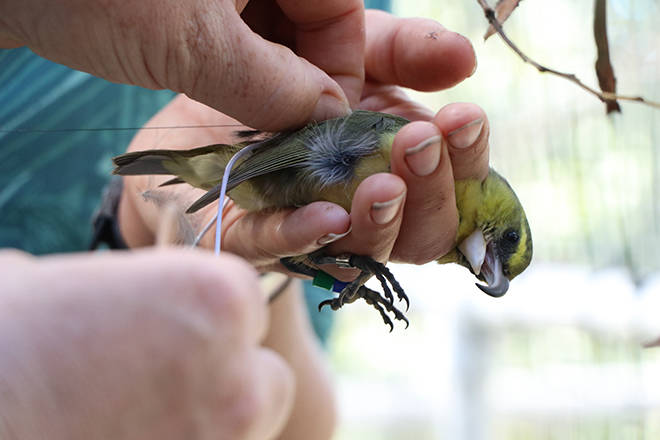A multiagency campaign to establish a second population of one of Hawaii’s most critically endangered birds got off to a dreadful start, with at least nine of 13 kiwikiu apparently succumbing quickly to avian malaria, officials said Tuesday.
The program, at least seven years in the planning, has been put on hold until scientists can figure out what to do next.
“We’re still reeling from this,” said biologist Chris Warren of the Maui Forest Bird Recovery Project.
The kiwikiu, also known as the Maui parrotbill, is a yellow and olive-green Hawaiian honeycreeper with a declining population found in a shrinking range of less than 7,400 acres high on the windward slopes of Haleakala. The current population is estimated to number anywhere from 44 to 312.
The U.S. Fish and Wildlife Service 2006 Hawaiian Forest Bird Recovery Plan recommended creating an insurance population of
kiwikiu, and the 1,420-acre Nakula Natural Area Reserve was established in 2011 on the leeward side of Haleakala in anticipation of the recovery effort.
The plan was to capture a group of wild kiwikiu in the Hanawi Natural Area Reserve and bring them together with a group of kiwikiu raised in captivity at the Maui Bird Conservation Center, placing them in field aviaries at the release site in late October.
But of the 13 birds taken to the 5,100-foot level of Nakula for release, five captive birds and four wild ones died within a few weeks, some even before they were released. Another bird remained missing in action.
Two males and one female were surviving and forging on native plants and trees as of Tuesday afternoon.
Although officials are waiting for necropsy (animal postmortem) results, preliminary tests suggest the birds died from avian malaria, one of the major killers of forest birds in
Hawaii.
Project officials are urging the state to move quickly toward proposed new methods for controlling the mosquitoes that transmit the disease.
The problem, Warren said, is that coming up with an effective and approved method may be at least two years away.
“It feels like things aren’t going well for kiwikiu, despite our best efforts,” he said. “We’ve got to come up with a realistic Plan B. But it’s hard to see what that would be without dealing with the mosquitoes head-on. We need people to get fired up about it, or it might not happen. These birds are found nowhere else.”
Warren said project members were anticipating challenges of food availability and predators. He said they didn’t think malaria would be the project’s greatest threat, given a variety of
factors.
Avian malaria has forced Hawaii’s forest birds into high mountain forests. But as climate is warming, avian malaria-infected mosquitoes are continuing to reach higher elevations. At least one recent study predicts multiple extinctions if global warming continues at its current pace.
State officials say species recovery efforts almost always have setbacks and a certain amount of mortality.
“When you’re dealing with a species, estimated to have only between 44-312 birds, it’s tough to lose even one of them. However, everyone on the capture and release teams understands that this type of project rarely has a 100% survival rate,” said Hanna Mounce, project coordinator with the Maui Forest Bird Recovery Project, in a news release.
The recent introduction of the Hawaiian crow into the wilderness of the Puu Makaala Natural Area Reserve didn’t start off smoothly two years ago. The first release was aborted after a two alala were attacked by predators, but now there are nearly 30 crows in the wild.
Warren that while he is sad for the loss of the individual kiwikiu, he doesn’t think the effort is going backward.
“We’ve learned an immense amount,” he said.
Before the release occurred, the birds were given veterinary exams to determine their suitability for the program. After being moved to Nakula, the birds spent 10 days in field aviaries, adjusting to their new surroundings.
Prior to the release, they were outfitted with tiny radio transmitters to help researchers track their movements over a month and a half. Preliminary results indicate the surviving birds are foraging relatively close to their release sites, but on certain days ranging as far as a kilometer away.
Project partners also include the state Division of Forestry and Wildlife, San Diego Zoo Global, the U.S. Fish and Wildlife Service and the American Bird Conservancy.
Officials said they plan to continue tracking surviving birds in their new home. They had originally planned to add more captured wild birds in mid-November, but that remains on hold for now. According to a news release, additional captures and releases will not happen until next year at the earliest.
“This is not what we hoped for,” Warren said. “But translocations like this often see a mortality. If you keep at it, you will eventually be successful. That’s what I’d like to think will happen to us. We certainly aren’t giving up.”

